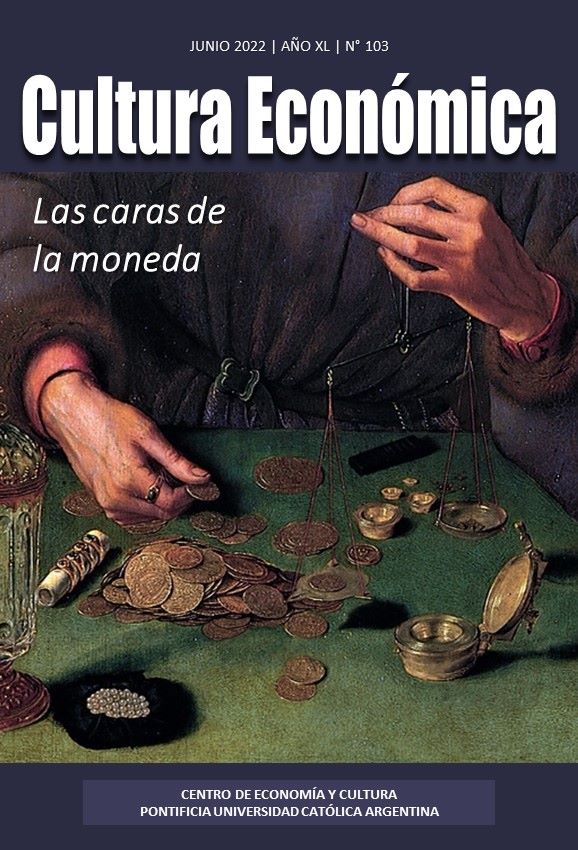The ontology of capital may better be explained by the concept of property rights
DOI:
https://doi.org/10.46553/cecon.40.103.2022.p23-38Keywords:
CAPITAL, ONTOLOGY, PROPERTY RIGHTS, DICHOTOMY, DOUBLE NATUREAbstract
The debate about the nature of capital has been portrayed as a dichotomy between capital as composed by material goods and capital as funds expressed in monetary terms. It has been recognized in the literature that the different ontologies discussed offer ‘at best a very partial account’ and that is the reason why a more comprehensive ontology of capital is needed. This paper explores how much that portrait is accurate historically and as a depiction of the current state of the debate about the nature of capital. It concludes with the idea that such a view is in general a correct one, and that the notion of property claims over goods that exist in the real world is the answer to the need for a more complete ontology of capital.Downloads
References
Böhm-Bawerk, E. (1881). “Whether legal rights and relationships are economic goods”. En Nymeyer, F. (ed.) (1962). Shorter Classics of Böhm-Bawerk (Vol I, pp. 25-138). South Holland, IL: Libertarian Press.
Braun, E. (2020). “Capital as in capitalism, or capital as in capital goods, or both?”. Review of Austrian Economics, 33, 383-395. Publicado por primera vez en línea el 15 de febrero de 2018.
Endres, A. M., & Harper, D. A. (2020). “Capital in the history of economic thought: charting the ontological underworld”. Cambridge Journal of Economics, 44(5), 1069-1091.
Hicks, J. (1974). “Capital controversies: ancient and modern”. The American Economic Review, 64(2), 307-316. www.jstor.org/stable/1816058
Kirzner, I. (1974). “The theory of capital”. En Dolan, E. G. (ed.) (1976). The Foundations of Modern Austrian Economics (Part 3, Essay 3). Kansas City: Sheed y Ward.
Lachman, L. (2007) [1956]. Capital & Its Structure. Auburn, AL: Ludwig von Mises Institute.
Merriam-Webster Online Dictionary (2020). “9 Financial words with surprising origins - a capital bruise, a budget of news, the fund of a bottle, and more”. Words at Play. Recuperado en línea el 21 de septiembre de 2020: https://www.merriam-webster.com/words-at-play/financial-word-origins/capital
Nersisyan, Y., & Wray, R. L. (2019). “How to pay for the green new deal”. Working Paper N° 931. Levy Economics Institute, Bard College, NY, Mayo. https://www.levyinstitute.org/publications/how-to-pay-for-the-green-new-deal
Rasmussen, D. B., & Den Uyl, D. (2020). The Realist Turn: Repositioning Liberalism. Cham, Switzerland: Palgrave MacMillan.
Rueff, J. (1964). El Orden Social. Madrid: Ediciones de Aguilar, S.A.
Smithin, J. (2008). “The rate of interest, monetary policy, and the concept of ‘thrift’”. International Journal of Political Economy, 37(2), 26-48.
Smithin, J. (2018). Rethinking the Theory of Money, Credit, and Macroeconomics: A New Statement for the Twenty-First Century. Lanham, MD: Lexington Books.
Soto, H. de (1989). The Other Path: The Economic Answer to Terrorism. New York, NY: Basic Books.
Soto, H. de (2000). The Mystery of Capital. New York, NY: Basic Books.
Zelmanovitz, L. (2016). The Ontology and Function of Money: The Philosophical Fundamentals of Monetary Institutions. Lanham, MD: Lexington Books.
Zelmanovitz, L. (2019). “Modern monetary theory and the moral equivalent of war”. Law & Liberty. https://lawliberty.org/modern-monetary-theory-and-the-moral-equivalent-of-war/
Zelmanovitz, L. (2021). The Representational Theory of Capital – Property Rights and the Reification of Capital. Lanham, MD: Lexington Books.
Zelmanovitz, L. (2022). “The Ontology of Capital Explained by the Notion of Property Claims”. Aurora Philosophy Institute Journal, 1(1), 1-18. https://www.theapi.ca/sites/default/files/API_Research/2021-11/AAAZELMANOVITZ_FINAL_TAPIJ.pdf
Zuniga, G. (1999). “An ontology of economic objects”. American Journal of Economics and Sociology, 58(2), 299-312. https://mpra.ub.uni-muenchen.de/5566/1/MPRA_paper_5566.pdf
Downloads
Published
How to Cite
Issue
Section
License













